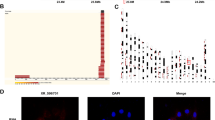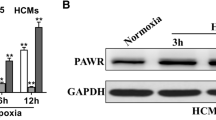Abstract
Background
Exosomes are involved in cell-to-cell communication in numerous diseases including cardiovascular diseases, neurological diseases. Little attention has been dedicated to exosomal circular RNAs in obstructive sleep apnea (OSA)-related cardiovascular diseases. The aim of this study was to explore the role of exosomal circular RNA ZNF292 (circZNF292) on AC16 cells exposure to intermittent hypoxia (IH).
Methods
Exosome release inhibitor GW4869 was used to examine the effect of exosomes on IH-induced AC16 cells apoptosis. The expression of exosomal circZNF292 was detected by qRT-PCR in AC16 cells exposure to IH, and a luciferase reporter assay was conducted to confirm the connection between circZNF292 and miR-146a-5p. Exosomal circZNF292 was stably transfected with short hairpin RNAs (shRNAs) against circZNF292 and co-cultured with AC16 cells. The expression of miR-146a-5p and apoptosis-related protein was then measured to evaluate the effect of exosomal circZNF292.
Results
We found that IH contributed to the AC16 cells apoptosis, and the administration of GW4869 increased the apoptosis of cardiomyocytes when exposed to IH. The expression of exosomal circZNF292 decreased and miR-146a-5p increased significantly in AC16 cells exposed to IH compared to normoxic conditions. Bioinformatics analysis predicted a circZNF292/miR-146a-5p axis in IH-induced cardiomyocytes apoptosis. The dual-luciferase reporter system validated the direct interaction of circZNF292 and miR-146a-5p. Knockdown of circZNF292 increased the expressions of miR-146a-5p and accelerated the AC16 cardiomyocytes apoptosis.
Conclusions
The findings of this study suggested a novel mechanism by which exosomes transmit intrinsic regulatory signals to the myocardium through the exosomal circZNF292/miR-146a-5p axis. This finding highlights the potential of targeting this pathway as a therapeutic approach for treating cardiovascular diseases associated with OSA.






Similar content being viewed by others
Data availability
The datasets generated during and/or analyzed during the current study are available from the corresponding author on reasonable request.
References
Bauters F, Rietzschel ER, Hertegonne KB, Chirinos JA (2016) The link between obstructive sleep apnea and cardiovascular disease. Curr Atheroscler Rep 18(1):1
Baguet JP, Barone-Rochette G, Tamisier R, Levy P, Pepin JL (2012) Mechanisms of cardiac dysfunction in obstructive sleep apnea. Nat Rev Cardiol 9(12):679–688
Wu J, Stefaniak J, Hafner C, Schramel JP, Kaun C, Wojta J, Ullrich R, Tretter VE, Markstaller K, Klein KU (2016) Intermittent hypoxia causes inflammation and injury to human adult cardiac myocytes. Anesth Analg 122(2):373–380
Lin G, Huang J, Chen Q, Chen L, Feng D, Zhang S, Huang X, Huang Y, Lin Q (2019) miR-146a-5p mediates intermittent hypoxia-induced injury in H9c2 cells by targeting XIAP. Oxid Med Cell Longev 2019:6581217
Kogure T, Yan IK, Lin WL, Patel T (2013) Extracellular vesicle-mediated transfer of a novel long noncoding RNA TUC339: a mechanism of intercellular signaling in human hepatocellular cancer. Genes Cancer 4(7-8):261–272
Kenneweg F, Bang C, Xiao K, Boulanger CM, Loyer X, Mazlan S, Schroen B, Hermans-Beijnsberger S, Foinquinos A, Hirt MN et al (2019) Long noncoding RNA-enriched vesicles secreted by hypoxic cardiomyocytes drive cardiac fibrosis. Mol Ther Nucleic Acids 18:363–374
Li Y, Zheng Q, Bao C, Li S, Guo W, Zhao J, Chen D, Gu J, He X, Huang S (2015) Circular RNA is enriched and stable in exosomes: a promising biomarker for cancer diagnosis. Cell Res 25(8):981–984
van der Pol E, Boing AN, Harrison P, Sturk A, Nieuwland R (2012) Classification, functions, and clinical relevance of extracellular vesicles. Pharmacol Rev 64(3):676–705
Abu N, Jamal R (2016) Circular RNAs as promising biomarkers: a mini-review. Front Physiol 7:355
Ren Q, Li H, Wang X (2019) The circular RNA ZNF292 alleviates OGD-induced injury in H9c2 cells via targeting BNIP3. Cell Cycle 18(23):3365–3377
Xie C, Zhu R, Tian Y, Wang K (2017) Association of obstructive sleep apnoea with the risk of vascular outcomes and all-cause mortality: a meta-analysis. BMJ Open 7(12):e013983
Joyeux-Faure M, Stanke-Labesque F, Lefebvre B, Beguin P, Godin-Ribuot D, Ribuot C, Launois SH, Bessard G, Levy P: Chronic intermittent hypoxia increases infarction in the isolated rat heart. J Appl Physiol (1985) 2005, 98(5):1691-1696.
Belaidi E, Joyeux-Faure M, Ribuot C, Launois SH, Levy P, Godin-Ribuot D (2009) Major role for hypoxia inducible factor-1 and the endothelin system in promoting myocardial infarction and hypertension in an animal model of obstructive sleep apnea. J Am Coll Cardiol 53(15):1309–1317
Totoson P, Fhayli W, Faury G, Korichneva I, Cachot S, Baldazza M, Ribuot C, Pepin JL, Levy P, Joyeux-Faure M (2013) Atorvastatin protects against deleterious cardiovascular consequences induced by chronic intermittent hypoxia. Exp Biol Med (Maywood) 238(2):223–232
Kohler M, Stradling JR (2010) Mechanisms of vascular damage in obstructive sleep apnea. Nat Rev Cardiol 7(12):677–685
Haque S, Harries LW (2017) Circular RNAs (circRNAs) in health and disease. Genes (Basel) 8(12):353
Sahoo S, Losordo DW (2014) Exosomes and cardiac repair after myocardial infarction. Circ Res 114(2):333–344
Lee JH, Song SY, Kim MS, Yoo NJ, Lee SH (2016) Frameshift mutations of a tumor suppressor gene ZNF292 in gastric and colorectal cancers with high microsatellite instability. APMIS 124(7):556–560
Boeckel JN, Jae N, Heumuller AW, Chen W, Boon RA, Stellos K, Zeiher AM, John D, Uchida S, Dimmeler S (2015) Identification and characterization of hypoxia-regulated endothelial circular RNA. Circ Res 117(10):884–890
Sluijter JP, Verhage V, Deddens JC, van den Akker F, Doevendans PA (2014) Microvesicles and exosomes for intracardiac communication. Cardiovasc Res 102(2):302–311
Chen W, Quan Y, Fan S, Wang H, Liang J, Huang L, Chen L, Liu Q, He P, Ye Y (2020) Exosome-transmitted circular RNA hsa_circ_0051443 suppresses hepatocellular carcinoma progression. Cancer Lett 475:119–128
Sun J, Li B, Shu C, Ma Q, Wang J (2020) Functions and clinical significance of circular RNAs in glioma. Mol Cancer 19(1):34
Ge X, Meng Q, Zhuang R, Yuan D, Liu J, Lin F, Fan H, Zhou X (2019) Circular RNA expression alterations in extracellular vesicles isolated from murine heart post ischemia/reperfusion injury. Int J Cardiol 296:136–140
Shimada BK, Yang Y, Zhu J, Wang S, Suen A, Kronstadt SM, Jeyaram A, Jay SM, Zou L, Chao W (2020) Extracellular miR-146a-5p induces cardiac innate immune response and cardiomyocyte dysfunction. Immunohorizons 4(9):561–572
Shu L, Zhang W, Huang G, Huang C, Zhu X, Su G, Xu J (2019) Troxerutin attenuates myocardial cell apoptosis following myocardial ischemia-reperfusion injury through inhibition of miR-146a-5p expression. J Cell Physiol 234(6):9274–9282
Funding
This research was funded by the National Natural Science Foundation of China (No.81900090), Natural Science Foundation of Fujian Province (No. 2020J01987), Youth Research Fund from Health and Family Planning Commission of Fujian Province (No.2020QNA053), and Startup Fund for Scientific Research of Fujian Medical University (No.2019QH1069). The sponsor had no role in the design or conduct of this research.
Author information
Authors and Affiliations
Corresponding author
Ethics declarations
Ethics approval and consent to participate
The article does not contain any studies with human participants or animals.
Conflict of interest
The authors declare no competing interests.
Additional information
Publisher’s note
Springer Nature remains neutral with regard to jurisdictional claims in published maps and institutional affiliations.
Rights and permissions
Springer Nature or its licensor (e.g. a society or other partner) holds exclusive rights to this article under a publishing agreement with the author(s) or other rightsholder(s); author self-archiving of the accepted manuscript version of this article is solely governed by the terms of such publishing agreement and applicable law.
About this article
Cite this article
Xie, HS., Huang, JF., Lin, QX. et al. The role of exosomal circular RNA ZNF292 in intermittent hypoxia-induced AC16 cardiomyocytes injury. Sleep Breath 28, 319–329 (2024). https://doi.org/10.1007/s11325-023-02920-2
Received:
Revised:
Accepted:
Published:
Issue Date:
DOI: https://doi.org/10.1007/s11325-023-02920-2




